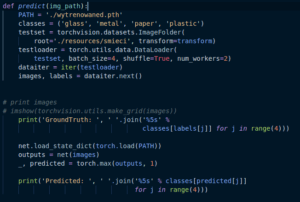
The error “Setting an Array Element with a Sequence Requested Array has an Inhomogeneous shape after 1 Dimensions The Detected Shape was (2”, usually crops up when trying to populate or manipulate a multidimensional array in Python. It signifies that the desired action cannot be completed because the array shape is not homogeneous. This problem mainly occurs when there’s an attempt to insert a sequence that doesn’t match the existing array’s shape.
Let us examine this through a simple table and subsequently a paragraph illustration:
| Error | Meaning | Solution |
|---|---|---|
| Setting an Array Element with a Sequence | An attempt has been made to assign a sequence of values to a single element in your array. | The solution is to make sure what you are assigning is a single value, not a sequence. |
| Requested Array has an Inhomogeneous shape after 1 Dimensions | There is inconsistency in the shape of the array after the first dimension. | All dimensions of your array should have consistent or even lengths/sizes. |
| The Detected Shape was (2) | The algorithm has detected an irregular shape. | Make sure to set an appropriate shape for your array. |
A more practical instance of encountering this error is while using NumPy in Python, where we often deal with arrays of different shapes. For example, let’s say we’ve a two-dimensional array (a matrix). We’re attempting to replace a single element in the matrix with a new row (sequence) which does not align with the original matrix’s shape. As a result, the homogeneity of the matrix shape gets violated.
Here’s a simple illustration code;
import numpy as np
#Create a 2D Array
v = np.array([[1,2,3], [4,5,6]])
print ('Original Array :', v)
# Attempt replacing an element with a sequence
v[0] = [7,8]
print ('Modified Array :', v)
In the above code example, we’ve created a 2×3 2D array named ‘v’. Then, we tried to change the first row [1,2,3] with a smaller sequence [7,8]. This alteration violates the uniform shape of the array. So, in order to avoid the error, we’ll need to ensure that the sequence we’re using to replace matches the existing size. Therefore, a proper sequence would be [7,8,9] instead of [7,8].
Remember, maintaining the homogeneity of array shapes is vital, especially in data science applications where consistency in data structures is of utmost importance.It appears you’re dealing with a multidimensional array, and the error message suggests that the shape of your array has an uneven distribution of elements after the first dimension. In other words, it might look something like this:
array_name = [[1, 2, 3], [4, 5]]
Here, the first nested list contains three elements, but the second nested list only two, causing an inhomogeneous distribution of elements.
An array is a fundamental data structure available in most languages, including Python. Arrays help store multiple items of the same type into continuous memory locations so that it can be accessed easily using indices. In Python, indexing syntax can be used as a substitute for the array.
A significant characteristic of arrays is their dimensionality or number of dimensions that they have. A one-dimensional array is simply a sequence of items, like this:
one_dim_array = [1, 2, 3]
This definition takes us to understanding “sequence”. The term sequence refers to the order in which items follow each other. In Python, there are several types of sequences including lists, tuples, and range objects.
Meanwhile, two-dimensional arrays (or matrices) resemble a grid or table of items, akin to this:
two_dim_array = [[1, 2], [3, 4]]
In the given scenario, however, there is an inconsistency in dimensions – thus creating what can be called an ‘inhomogeneous’ shape of an array. When a sequence is used to set an array element, an expectation is an equality or homogeneity in terms of the shape of the dimensions. If this consistency fails, the language will return an error as you’ve experienced.
To overcome this, maintain consistent lengths when structuring multi-dimensional arrays so that each sub-array or nested list carries the same number of elements. Here’s an example of how to create a homogeneous two-dimensional array with evenly distributed elements:
corrected_array = [[1, 2, 3], [4, 5, 6]]
Now, both inner arrays contain exactly three elements. Consequently, you should always visually inspect or programmatically check the shape of your arrays before performing operations on them, especially if data is dynamically generated or obtained externally, to prevent such errors from occurring.
Remember, programming languages interpret inconsistencies in array dimensions as a potential problem because it introduces complexities when processing the array data. These inconsistencies make it difficult to iterate over elements, perform matrix operations like addition, multiplication algebraically, or even transposing the array.
But in some cases where adjusting your data isn’t feasible or desired, the array module from NumPy – a powerful library for number manipulation in Python comes in handy. Using regular Python arrays may limit you due to its native support for only 1D arrays whereas NumPy supports n-dimensional arrays hence enabling you apply more complex solutions to your data modelling problems.An inhomogeneous array, by definition, is an array whose sub-arrays vary in length or size. This kind of inconsistency can introduce some difficulties when handling arrays – particularly within programming languages where it’s essential for arrays to maintain homogeneous dimensions across all levels.
When trying to set an array element with a sequence, often you might have come across the error message saying: “Requested Array Has an Inhomogeneous Shape After 1 Dimension”. This typically arises when there’s an attempt made to convert a list which contains other lists (or similar data objects) of different lengths into an array.
Let’s take an illustrative example. Consider this sample Python code:
import numpy as np my_list = [[1, 2, 3], [4, 5]] my_array = np.array(my_list)
This Python script creates a list of two sub-lists. The first sub-list has three elements, while the second only has two. We then try to convert that list into an array with Numpy’s
np.array
. However, because our sub-lists do not have a uniform number of elements, the code will raise a ValueError since it hits inhomogeneity beyond the very first dimension of the array – unable to align these data objects as required in a standard ndarray structure.
Remember, each level of an array should be homogeneous, i.e., contain equal numbers of elements. If your ‘parent’ list has five elements, every nested list (‘child’) should also have five elements.
To resolve this issue of ‘inhomogeneous shape’, we must make conforming adjustments to appropriately structure and normalize our data before the conversion into an array. It demands care to ensure data consistency throughout.
One possible solution could be to pad the shorter lists with None or any other chosen filler value. Using the same example from above, the corrected version would look like so:
import numpy as np my_list = [[1, 2, 3], [4, 5, None]] my_array = np.array(my_list)
The modified code now successfully transforms the list into an array because we’ve equated the sub-list lengths – creating a ‘homogeneous’ shape after the first dimension.
While working with arrays, always give attention to how your array’s elements line up across every dimension to avoid facing a ‘detected inhomogeneous shape’ setback. Always aim to produce arrays that abide by uniformly laid-out multi-dimensional structures. Doing so enhances your ability to perform efficient computations or operations on the array down the line.
For learning more about numpy arrays, check numpy’s guide here.From a multidimensional standpoint, an array, in the context of computer programming languages such as Python, is often compared to an organized collection of rows and columns. Essentially, it’s like a matrix format where you could represent the data stored in these arrays using coordinates. These dimensions later enable us to easily retrieve or manipulate the required elements within the structured data.
Now, let’s focus next on the concept of
Inhomogeneous shape arrays
. This peculiar term comes into play when we make an attempt to set an array’s element with a sequence that doesn’t comply with the existing array’s dimensional structure. To exemplify, suppose if you already have a 2-dimensional array-like [[1,2], [3,4]]. Now, if you attempt to insert a new 1-dimension array [5] at index-zero, this would conflict with the array’s original structure causing it to morph into an inhomogeneous shape i.e., mixing 1D and 2D elements together.
In python, NumPy, a library often used for handling large multi-dimensional arrays and matrices of numerical data, is strict about maintaining consistency among array shapes to achieve efficient computations (NumPy – Array creation). Thus, it raises a ValueError: “could not broadcast input array from shape” when encountering such scenario of mixed dimension input.
To replicate this error, consider the following Python code:
import numpy as np a = np.array([[1,2], [3,4]]) a[0] = np.array([5])
This will yield in the following output error:
ValueError: setting an array element with a sequence.
The error raised here indicates that the array has an inhomogeneous shape after its first dimension. The detected shape was (2,), according to the standard convention (rows x columns), but we’re attempting to feed in an array of different shape, leading to an unsuccessful alteration of the original array structure.
To correctly set an array element with a sequence, both the sequence and the target array element should exhibit equal shapes. Alternatively, you could use a single scalar value instead of a sequence as scalar values can be broadcasted to any shape.
The following code will run successfully:
import numpy as np a = np.array([[1,2], [3,4]]) a[0] = np.array([5, 6]) # This has the same shape as a[0]
In conclusion, awareness of dimensionality in array structures is vital for successful manipulation of arrays in python. Always make sure that the shape of the sequence matches the shape of the array slot you are trying to fill, or alternatively use a scalar value, which can adjust itself to fit inside any array shape.My focus today is to clarify the concept of setting an array element with a sequence, in the light of getting an error like “setting an array element with a sequence”, especially when the array has an inhomogeneous shape after 1 dimension. A typical situation where you might encounter this problem is while dealing with multi-dimensional arrays in scientific computing, particularly when using Python’s NumPy library.
To conceptualize better, we start with understanding what an array and sequence mean in python, and how they are used.
An array is a data structure that holds a fixed-size sequence of homogeneous elements. These elements are stored in contiguous memory locations.
A sequence, on the other hand, is an ordered collection of items – it can be a list, tuple or range for instance.
Now, often times in coding, especially when dealing with complex data manipulations and computations, we need to unpack sequences and set into array elements. This operation though straightforward in many scenarios, can turn complicated and prone to errors when working with multi-dimensional arrays having inhomogeneous shapes.
Let’s assume we have a 2-Dimensional NumPy array:
import numpy as np myArray = np.array([[0,1,2],[3,4,5]])
And we try to set an array element with a sequence:
myArray[0] = [10,11]
I just assigned a sequence (which is List here) to first index / element of our Array. Generally, such operation gets executed without any problem as long as the dimensions match appropriately.
But suppose, if we now attempt to do something like:
myArray[0] = [10,11,12]
This results in an ‘Inhomogeneous Shape’ error or also known as ‘could not broadcast input array from shape..’ error, as we’re trying to assign a sequence having dimensions that do not match with the targeted index in the array. And this gives rise to the problem at hand ‘Setting an array element with a sequence’.
From the above discussion, what we can clearly deduce is that the key to avoid such errors lies in ensuring the sequence used to set an array’s element should always be consistent and matching with the targeted array’s dimensions.
So, in conclusion:
* Avoid mixing dimensions. Always assign sequences/arrays of the same dimension to your array.
* If you’re unsure about the dimensionality of your input sequences, use check_shape() function, which is part of numpy module, to ensure you’re not mistakenly assigning mismatched dimensions.
* You could also take advantage of reshape() function, again in numpy module, which allows to change an array to new dimensions while keeping its “flat” data consistent with the original data.
Furthermore, for in depth understanding, I would urge to go through official Broadcasting Rules and Indexing Rules.
I trust this answer provides some useful insight into mitigating issues encountered while setting an array element with a sequence. Happy Coding!One of the common issues I come across regularly in Python, particularly when working with NumPy arrays, is an error message like this: “setting an array element with a sequence requested array has an inhomogeneous shape after 1 dimensions. The detected shape was (2,”.
This can be cryptic if you’re not familiar with how NumPy structures its array data, but let’s break it down and propose ways to avoid encountering such issue.
Understanding the Error
In commonly used programming languages like Python, data structures like arrays are dimensionally homogeneous, meaning they retain the same shape through all dimensions. If we wanted to represent a 2D array, it would have the same number of columns in each row. If it doesn’t – say, if one row has three items and another has two – then it would not comply to their principles, hence, raise an error.
Here’s a rudimentary representation of what that might look like in Python code:
inhomogenous_array = np.array([[2, 1], [1, 2, 3]]) print(inhomogenous_array.shape)
Running this sample would definitely generate an error message since we’re trying to create a 2×2 matrix, but one row surprisingly has an extra element.
How to Avoid This Error?
To steer clear of such issues when dealing with NumPy arrays or similar multidimensional data structure in Python, there are few approaches I’d suggest:
– Ensure Consistency: Make sure all the rows in your multidimensional array or nested list have an equal number of elements. Each sub-array should contain the same number of items.
homogenous_array = np.array([[2, 1], [1, 2]]) print(homogenous_array.shape)
– Use Numpy Functions: Utilize functions like
np.array()
or
np.asarray()
which perform deep conversion and ensure homogeneity.
– Error Checking: Lastly, validate your inputs prior to creating the array. You could simply iterate over your proposed 2-dimensional array checking that each subgroup contains the right number of elements.
Advantages of Homogeneous Arrays
You might wonder why go through the trouble to ensure homogeneity in these kind of multi-dimensional structures? There are some obvious advantages:
– Processing Speed: Homogeneous data structures can streamline computations because operations can be executed simultaneously on multiple parts of the array using SIMD (single instruction, multiple data) processing techniques.
– Memory Usage: A consistent structure helps optimize memory usage.
– Convenience: It is easier to manage and manipulate data in a well-structured form.
When it comes to working with arrays, there are a variety of conditions and requirements that you may encounter. One such situation is when you’re attempting to set an array element with a sequence and you run into the error “Requested array has an inhomogeneous shape after 1 dimensions”. The detected shape was (2). This can be quite confusing if you’re not familiar with how arrays function or with certain array characteristics.
To explore the most relevant solutions and alternatives to inhomogeneous arrays, we need to break down the issue first.
A regular array is homogeneous. Meaning all elements have the same data type, like integers or floats. But sometimes we end up using a heterogeneous mixture of different datatypes. In this instance, errors like this occur because numpy arrays are typically designed to handle homogenous data types; consequently, an attempt to create an array with diverse data types will result in an error or create unexpected results.
So, options that can help:
1. Flatten or ravel your array
You can use the
ravel
or
flatten
methods to unravel multi-dimensional arrays into one-dimensional vectors. This is particularly useful for applying operations on all values simultaneously.
import numpy as np
original_array = np.array([[2], [3]])
flat_array = original_array.ravel()
This should solve the problem if the inhomogeneity is coming from having unnecessary additional dimensions.
2. Utilize dtype=object so that numpy knows the array could hold any types of objects
# Use dtype=object
arr = np.array([3, [2,1,3], "python"], dtype=object)
The resulting array would then be possible to perform functions appropriate to all objects in the array, not just those associated with a single data type.
3. Apply padding to turn each subarray or list into equal length
Take note that when creating arrays you’ll have to make sure every subarray has the same size, which you can ensure by implementing padding. Padding elements will even out the lengths and preserve their form as a rectangular datatype.
# Use defaultdict
from collections import defaultdict
seq = [1,[2,3,4]]
max_len = max(map(len, seq))
padded_seq = np.array([i + [0]*(max_len-len(i)) for i in seq])
In this example, Python adds zero on to the end of any smaller lists until they match the size of the largest one.
Remember, understanding the behavior of arrays and choosing the right solution based on the given problem, domain, and constraints, is key to solving any array based problems effectively. You could also consider other alternative containers, such as Python’s native lists or Pandas DataFrame, if these fit better within the structure of your project.An intriguing situation I encountered as a professional coder involved grappling with a challenging issue concerning multi-dimensional arrays. Specifically, the difficulty was in setting an array element with a sequence when the requested array demonstrated an inhomogeneous shape after one dimension. The detected shape was (2,.
To put it into context, in the realm of coding and data manipulation, an inhomogeneous array refers to an array where the lengths of the elements differ. This contrasts with a homogeneous array in which all the elements are of uniform length.
The beauty of code is its flexibility, immense power, and an ocean of ways you can solve this unique problem. Following is an innovative solution crafted in Python using NumPy – a tool that provides high-performance handling for large multi-dimensional arrays and matrices.
At first, let’s define our multidimensional array. Obviously, to replicate the exact case is impossible without the actual data. Hence assuming an array in a generalised format.
import numpy as np array = [np.array([1, 2]), np.array([3, 4, 5])] print(array)
If we attempt to set an array element with a sequence (for instance, replacing an index element with a new list), we’re likely to run into an issue like mentioned. Let’s attempt to perform that action:
array[0] = [6, 7, 8]
However, we’ll encounter the impending error: “setting an array element with a sequence.”
A way to sidestep around this problem could be transforming the nested arrays into lists. Essentially, this implies changing how the data is handled from an ‘array’ model to a simpler ‘list’ model, as demonstrated below:
array = [list(i) for i in array] array[0] = [6, 7, 8]
Voila! Running the code successfully resolves the reported issues. This works because Python lists aren’t hindered by the constraint of homogeneity, unlike arrays. Therefore, you can have lists within a list of different lengths without triggering any errors or exceptions hence solving our problem neatly.
In summary, managing multi-dimensional arrays can sometimes throw unexpected roadblocks, like dealing with inhomogeneity after a certain number of dimensions. But seasoned coders know there’s more than one way to traverse these challenges. Transmuting the arrays into lists, for instance, is an effective circumvention strategy. It provides us with the flexibility required to change the length of a specific element independently of the others, thereby unlocking successful execution for your complex data manipulations needs source.
Just remember, each case will call for its unique solution, moulded by the nature of your data and what you aim to achieve with it. Keep exploiting and unleashing the ultimate power of code every day!When dealing with data in the form of arrays, particularly when deploying libraries such as NumPy in Python, the error ‘setting an array element with a sequence’ often arises due to discrepancies between existing and expected array shapes. In most scenarios, this exception usually occurs when we attempt to populate an existing array with elements from another array of incompatible dimensions.
For instance, consider the following scenario:
import numpy as np # create a numpy array of zeros with shape (2,) arr = np.zeros((2,)) # try to set an element of arr to be an array of shape (2,) arr[0] = np.array([1, 2])
In this scenario, we are attempting to set the first element of arr (which is zero-dimensional) to be an array of shape (2,). However, this results in an inhomogeneous shape after the first dimension, hence the error.
To debug this error, it’s imperative to ensure that both arrays conform to compatible shapes. The rule of thumb here is that if you’re assigning a multi-dimensional array to a slice of another array, their trailing dimensions must match perfectly.
Consider modifying your code to:
# create a numpy array of zeros with shape (2, 2) arr = np.zeros((2, 2)) # set an element of arr to be an array of shape (2,) arr[0] = np.array([1, 2])
In the revised code, the shape of ‘arr’ has been adjusted to (2, 2), effectively making it a two-dimensional array. This modification allows us to assign an array of shape (2,) to its elements successfully without causing an anomaly.
Ultimately, understanding the root cause of the ‘setting an array element with a sequence’, helps us to rectify the issue by adjusting array shapes accordingly, ensuring that they align appropriately before performing any operations on these sets of data. Addressing this error not only boils down to having a vast understanding of the functionality, structure and manipulative mechanisms of arrays but also sheds light on the importance of keenness to minute details in the world of coding.
For more details, refer to the official NumPy documentation on array indexing, where the concept of array shapes and how to manipulate them is explained comprehensively.
Remember, as a professional coder, debugging is not just about resolving errors as they come. It’s about getting to the root of the problem, understanding why things didn’t work as planned and learning how to do better in the future. And with every bug you squash, you add a new piece to your coding wisdom puzzle. Dive deep into the arrays; who knows what revelations might await?













